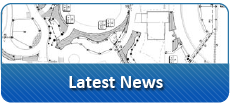Basic considerations for contracting irrigation design services include provider availability with design capabilities needed, independence from affiliation with product suppliers, cost of services, and contracting method (lump sum, hourly, etc.).
There are a variety of independent irrigation designers located in various US regions. To find an irrigation designer new you, check out ASLA’s Firm Finder or the American Society of Irrigation Consultants (ASIC).
Generally, expect to pay slightly more for independent irrigation design consultants compared to using a contractor or getting design assistance from an irrigation manufacturer. The benefits include higher quality, freedom to select any product best suited for the design needs, attention to detail, thorough information about total lifecycle cost of the system, full spectrum of maintenance considerations, and a wide range of bids for installers.
The contractor or irrigation manufacturer could place limits on the range products, not be open to substitutions, unable to approve using equivalent performance products, and might be tied to fewer installers. In some cases, shortcuts would include using a performance specification. Examples include placing the burden of pipe sizing based on a friction loss table on the field contractor, or pump sizing (flow, pressure, dynamic, and static head) and pump control definition delegated to the pump fabricator instead of being set by the designer.
Examples of a subconsultant agreement for irrigation design are available by contacting a member of the Irrigation Association (IA) or the American Society of Irrigation Consultants (ASIC).
Considerations for self-performing include knowledge of hydrology, hydraulic design fundamentals, up-to-date product performance knowledge, and staff capability. Advantages include more control over cost to produce the design, greater ability to make changes during design, bid phase or construction, and a long term ability to build knowledge and skill with each completed project; compared to contracting with others for irrigation design.
For water conservation, it can be a sales advantage for securing future projects to track water savings cumulatively per project. These records can be maintained from a consultant designer or by self-performing irrigation design.
Regular training sessions in irrigation design for staff are available from Irrigation Association (IA). Product information can be secured from national or regional product reps and by attending ASLA Chapter or ASLA Annual meeting and EXPO events.
Factors common to both delivery methods (self-perform or contract for services) include risk and liability control for design, establishing the design life, setting the minimum required design criteria (usually set by state, regional, county or local agency requirements plus irrigation industry professional society standards), and setting performance criteria set by the designer above and beyond the minimum codes; including ASIC, IA, LEED, LID, or SITES for water conservation and lifecycle cost benefit considerations for longevity of system service.
First, set high expectations for project outcomes such as protection of fresh water natural resources, disaster avoidance, and reduced potential for litigation or third party claims. Next, if you can’t meet your own high expectations using in-house irrigation design, then seek professional assistance from other providers. Documented litigation and paid claims settlements show irrigation designs have caused or contributed to loss of life, personal injury, plus direct or consequential property damage. Impacts are from too much (or not enough) water applied, overspray on vehicle travel areas or structures, and a wide array of technical problems; product failures (tolerable levels and unusual levels), over pressure, design errors, system leaks, properly designed system not inspected or tested after improper installation, irrigation system at a storm water facility enabling cross connection contamination due to backflow in the public water supply system. A failed irrigation system that compromises the top, face, or toe of a slope can cause a landslide in steep slopes or unstable soils. This might help evaluate the best choice:
- Do you know what liability and financial risk you will “own” by self-performing?
- Are you better off contracting with capable, insured professionals to control risk?
- After-the-fact, after a claim arises, will your decision to self-perform in-house instead of contracting for service based on cost be considered reasonable by one of your peers who is an expert?
- A safety, risk hazard and quality control checklist with a comprehensive list of factors for irrigation design is essential for in-house or consultant services by others.
To close out this month’s article, the big picture is that licensed landscape architects engage in proper irrigation design whether self-performed or contracted for water conservation.
Selected resources for more information:
- American Society of Irrigation Consultants
- Regulation of Landscape Architecture and the Protection of Public Health, Safety and Welfare, October, 2003, by American Society of Landscape Architects at page 39.
- Irrigation Association
- The Landscape Architect’s Portable Handbook, by McGraw-Hill in Chapter 19, pages 358 to 378, including 6 references.



